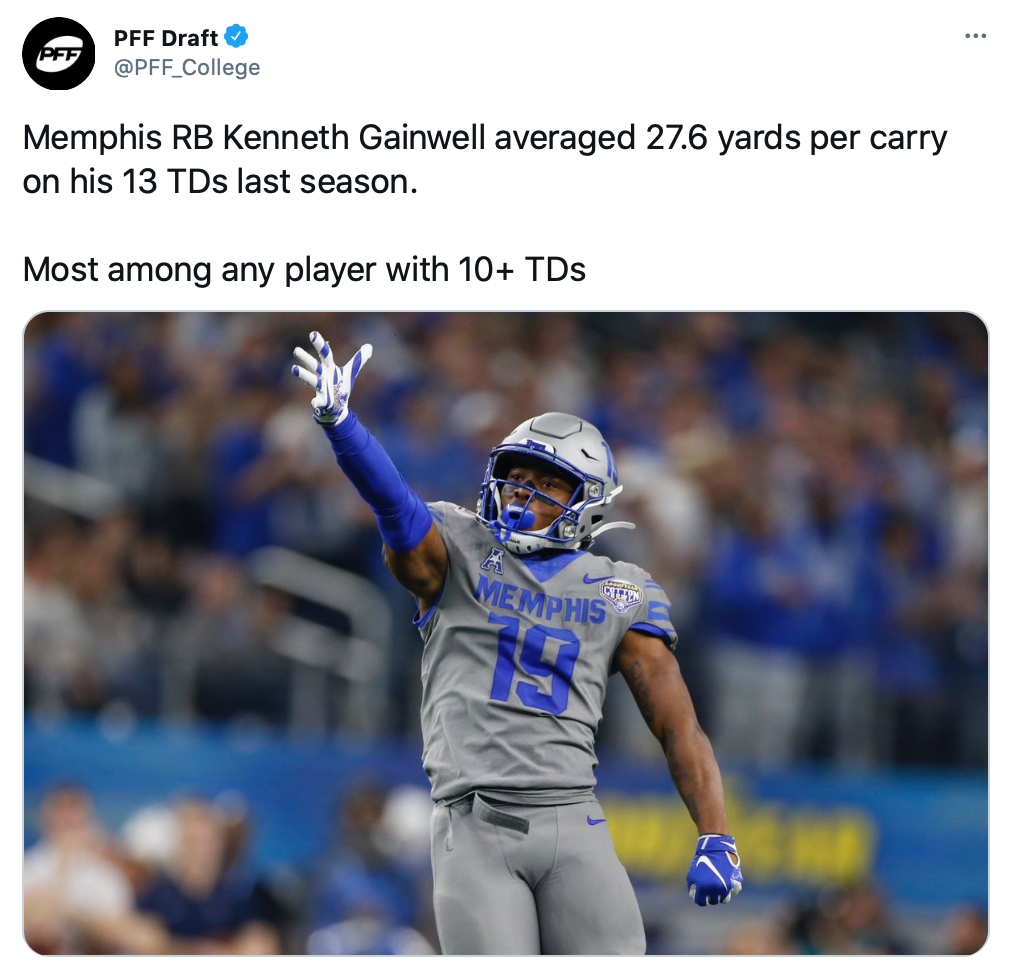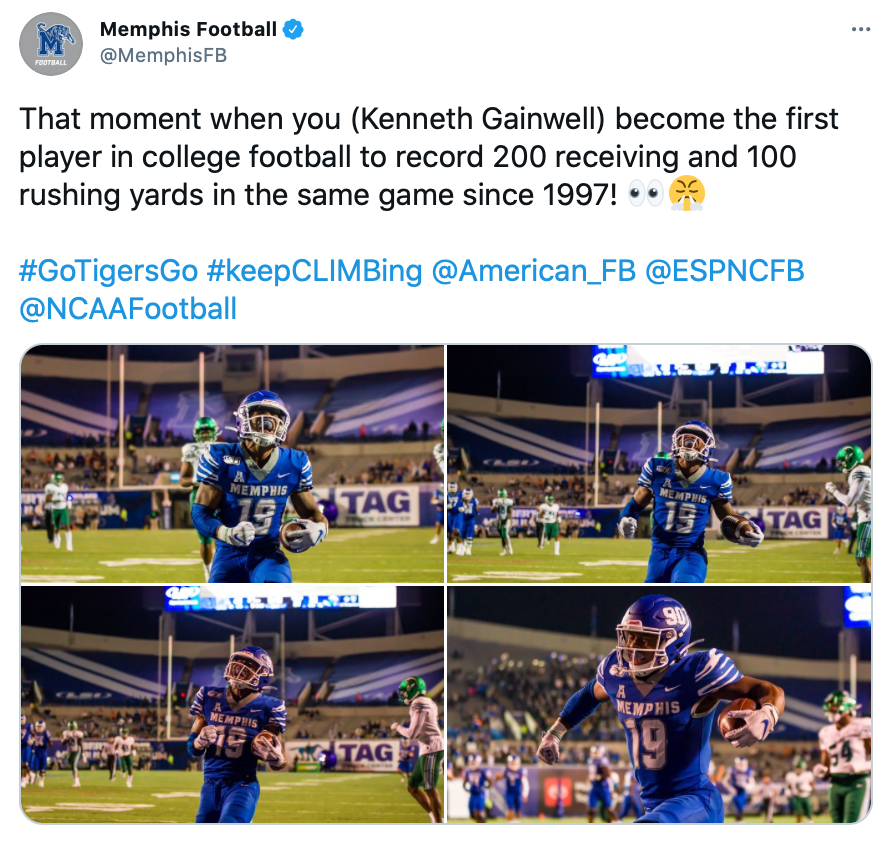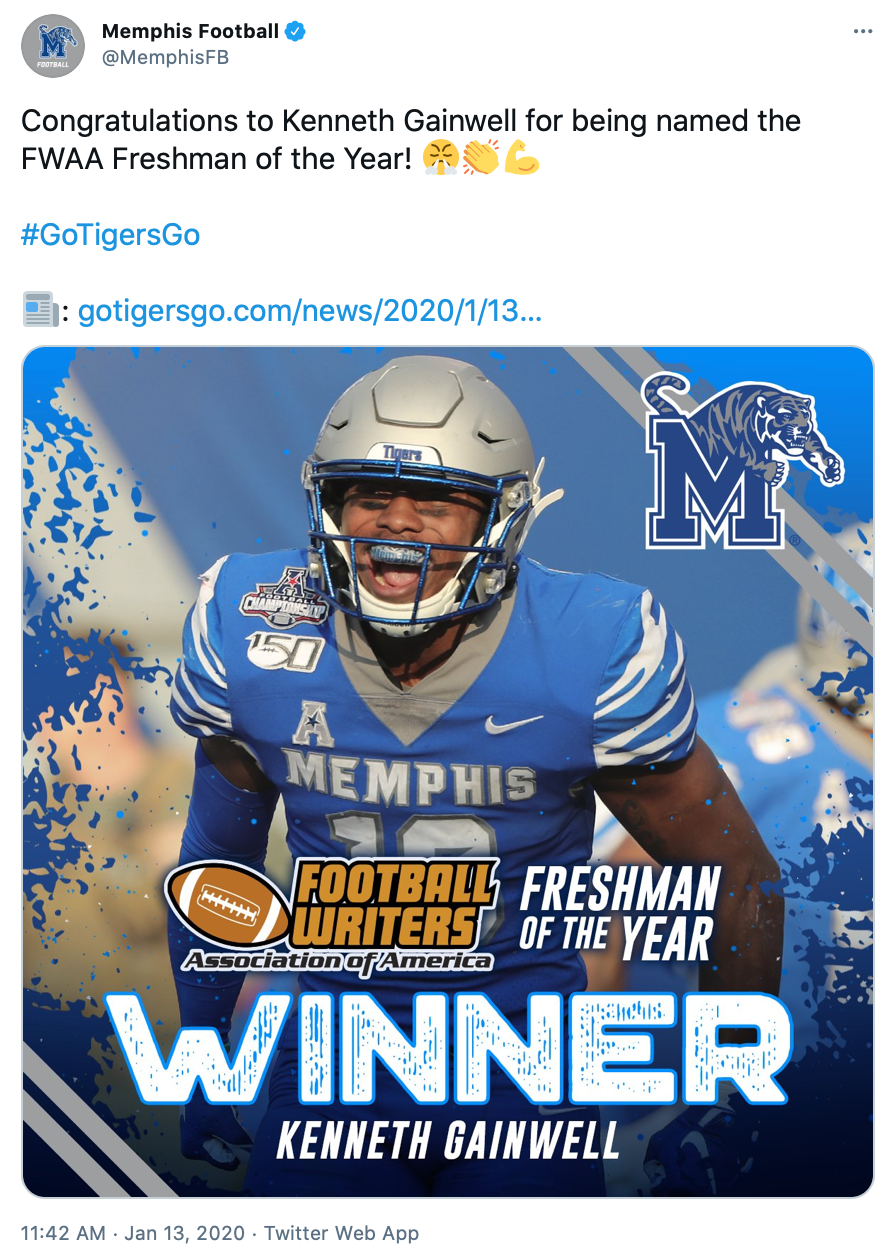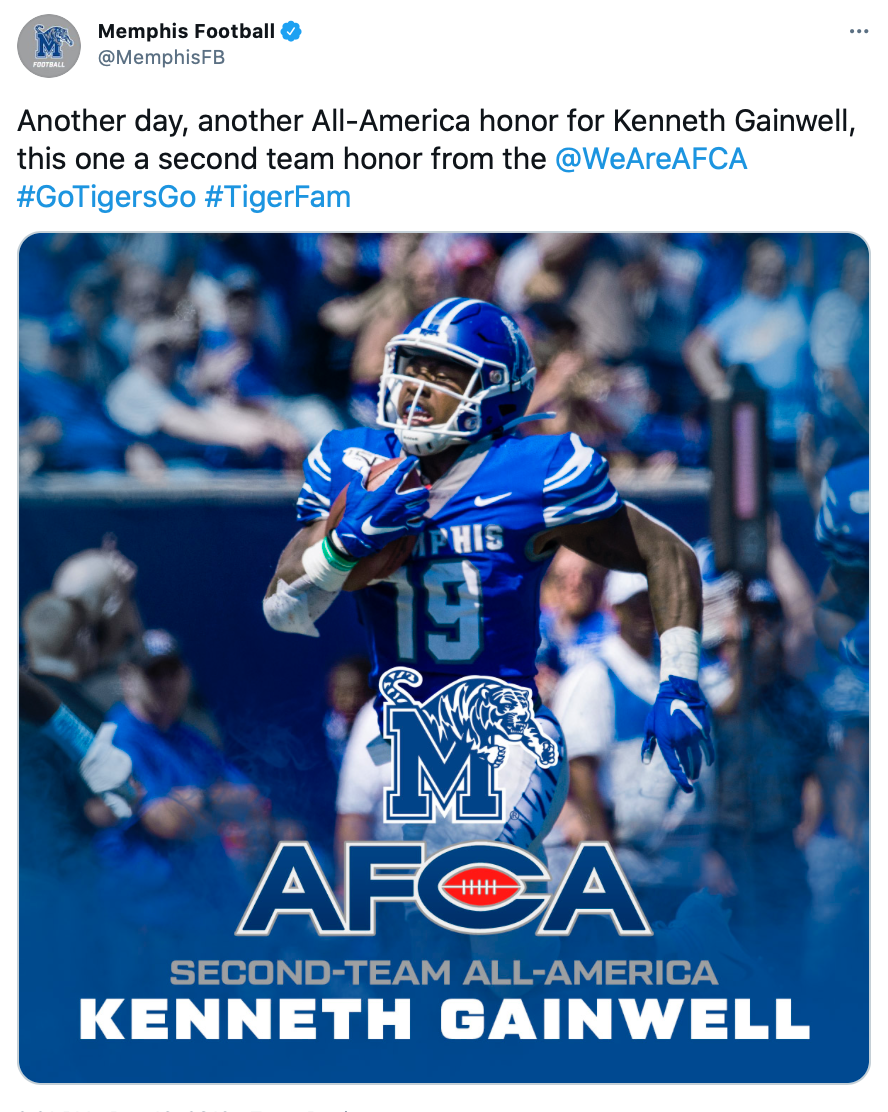Kenneth Gainwell
RB | Memphis Tigers | 5-11 | 195 lbs.
The Story
Nobody saw Kenneth Gainwell coming.
That is, of course, other than former Memphis director of recruiting and current Georgia defensive coordinator Dan Lanning. During his two-and-a-half recruiting seasons with the Tigers, Lanning signed Gainwell, Antonio Gibson, Tony Pollard, Darrell Henderson, Patrick Taylor, Damonte Coxie, Calvin Austin III, Tahj Washington, and Sean Dykes.
Given Memphis was the first team to offer Gainwell, it made a huge difference to the former Yazoo County High School (Mississippi) star. Sticking with him during some academic issues during his senior year sealed the deal, even when Lanning departed for Georgia prior to Gainwell officially getting to campus.
Digging into the psyche of Gainwell, his older brother, Curtis Gainwell Jr., was a walk-on at Southern Miss back in 2013-14. Just as with every other football player across the nation, Curtis was simply lifting weights to improve his athleticism when he suffered a stroke. An artery in his brain burst, causing a hemorrhage that would require four brain surgeries to correct. The toll of the experience cost Curtis the use of his right hand. His dream of playing college football came to an abrupt end. As a young teenager, the experience made a lasting impact on Kenneth. He knew everything could instantly come crashing down as his football career progressed.
Gainwell headlined his Yazoo County High School as the starting QB for three seasons. And it wasn’t a triple-option offense, like you might expect for a player who converted to running back in college. The Panthers utilized a modern, read-option spread using mostly 10- and 11-personnel. Gainwell rushed for over 4,400 yards on 9.4 YPC with 73 TDs during those three seasons. He led his HS to an appearance in the MHSAA Class 3A state championships his senior year, ending the season 14-1. In addition to Memphis, Gainwell was offered scholarships by Arkansas State, Louisiana-Lafayette, Tulane, Idaho, Alcorn State, Central Arkansas, and Ole Miss. Gainwell would make a late recruiting visit to The Vaught on January 26, 2018, but he stuck with his June 2017 commitment to Memphis.
Both Mississippi State and Ole Miss regret letting Gainwell slip through their fingers. Gainwell’s family roots in football includes his cousin Fletcher Cox, who is one of the top interior defenders in the game. Cousins Trebor Gainwell played LB at Southern Arkansas and Robert Gainwell — who also starred alongside Cox at Yazoo County — played safety for Alcorn State. His younger brother, Kory Gainwell, joined Memphis in their 2020 recruiting class, but has since entered the transfer portal. During Kenneth’s recruiting, Memphis told Gainwell they envisioned him as a RB, slot WR, kickoff, and punt returner. He had been learning the QB position on the job for Yazoo, so he didn’t exactly resist the position switch.
The Attributes
The HS scouting network did not see Gainwell as a strong prospect — pre-college positional ambiguity is often an issue for scouts. Taking part in The Opening Regional in 2017, Gainwell recorded a 4.68 second 40-yard dash, 4.41 short shuttle, and 36.8-inch vertical jump. That vertical speaks to Gainwell’s explosive playstyle, but the short shuttle time is perplexing. Coincidentally, it’s nearly the exact pre-college short shuttle time recorded by Kadarius Toney (4.43) — another former high school QB.
At his Memphis Pro Day on March 19th, Gainwell recorded a 4.42s 40-time. Since I had been keeping my eyes peeled for an updated short shuttle and the ultra-informative 3-Cone, it was pretty disappointing to see his measured a 14th-percentile shuttle time (4.46), and 18th-percentile 3-Cone time (7.26). If this is your first time reading one of my RB profiles, go ahead and toss all slow 40-yard times out of memory. We only care if the time is really good. Gainwell will not need track-star speed in 40-yard increments to be a successful NFL RB. At RB, the groundwork is all about vision, agility, and explosion. That updated 40-time is around the 85th percentile when adjusted for his 5-foot-11, 195-pound frame. Impressive. But his poor 3-Cone and Short Shuttle measurements send up a red flag for me. Especially for those holding out hope for a three-down role in the NFL. Without plus size, agility, or change of direction, the odds will be stacked against him in that regard.
If you find value in evaluating his Yazoo County QB work into his RB skillset, feel free to check out his senior season Hudl highlight reel. It certainly holds some weight, but I am avoiding it due to the combination of playing a different position, and facing vanilla competition nationally ranked outside the top-1,500 schools. It forces us to evaluate his NFL future using a hair over 650 Memphis snaps. Yes, more would help. His decision to opt out of the 2020 season was unfortunate, but understandable after losing four family members to COVID-19.
For his 2019 season as a redshirt freshman, we’ll use this highlight reel for his analysis. Let me be clear in stating that analyzing Gainwell must be done using far more than the 28 plays shown in these highlights. If you’d like to watch available Memphis footage from 2019 for yourself, here are links to the full games I used during my evaluation:
Ole Miss | Southern | Navy | at Temple | Tulane | at Tulsa | SMU | at Houston | at USF | Cincinnati (AAC CC) | at Penn State (BG)
One very appealing aspect of Gainwell’s game is success on run-pass options (RPOs). Modern football is relying more-and-more on athletic QBs able to demand respect for their rushing abilities on RPOs and Read-Options. It’s the responsibility of the RPO RB to surrender the decision to handoff, pull it back to pass, or to keep entirely to the QB. Even if the RB is not handed the ball, he must sell the run fake in order to draw attention away from his QB. You see far too many botched handoffs resulting in turnovers from RBs attempting to pull the ball from their QBs. The tactic requires restraint.
During the 2019 season, Gainwell generated half of his rushing yardage on RPOs from only one-third of his total attempts. We see Gainwell on an RPO on the first play of the video (0:16). He is led on the run by RG Manuel Orona-Lopez, known as a Frontside Pull Lead. Orona-Lopez overruns his block on Georgia State LB Ed Curney, but Gainwell is already out of his reach, and jump-cuts CB Ben Hood before taking it to the house. At the 6:59 mark in the video, another Frontside Pull Lead clears the way for Gainwell to throw down another jump-cut, evading Tulane’s primary contain.
We have our only Inside Zone blocking example in the film at 1:36. Using that jump-cut weapon, once again, Gainwell correctly identifies Temple only defending the six gaps with five defenders. DT Ifeanyi Maijeh is attempting to two-gap both A’s, for which Gainwell shows frontside A before cutting to the backside A (best viewed on the alternative view at 1:47). Our final RPO example is shown at 3:08 with Power blocking. The Power concept uses a backside puller to lead the way. The concept demands patience. But we can see that Gainwell switches to an alternative gap (frontside A) when Orona-Lopez is stood up by LB Isaiah Graham-Mobley in the intended C-gap.
Memphis used Frontside Pull Lead blocking more than any other concept for Gainwell. He responded with 7.6 YPC, a 21% increase over the remainder of his attempts. We see our first non-RPO example at 0:41 vs. Navy. Patience is not as important with Frontside Pull Lead’s since the O-lineman doesn’t have as far to travel. It suits Gainwell’s decisive cuts, quickness through traffic. At the end of the play, we do see a pair of Midshipmen defenders with 4.6-4.7 speed nearly chase him down from behind. NFL coaches will complain if Gainwell “only” gains 60 yards on this run. Gainwell is simply a guy you want to put into space. The Frontside Pull Lead pitch does precisely that at 2:33.
Unfortunately, the tackling fundamentals in the NFL are a tad better than he faced in the AAC. But Gainwell’s wiggle is sure fun to watch slipping through Cincinnati defenders at 2:54. Gainwell does not possess a bruising running style. At his reported 191 pounds, that shouldn’t come as a surprise. A good example is shown at 5:31 against Tulane. We see shiftiness and acceleration, but he is unable to extend this run the extra two yards for the score. It’s also one of the few examples where Gainwell takes a big shot. The final three Frontside Pull Lead examples are shown at 5:02, 5:46, and 7:27.
Oddly enough, we only have three Outside Zone examples in the reel. And only two-of-four Outside Zone TDs are displayed. Gainwell would have Outside Zone blocking on a fifth of his total carries, second most. The first is at 3:36, offering further evidence of his ability to manipulate the D-line in order to decisively attack his gap. He does the same at 6:13. His plus vision allows him to switch from his intended frontside A gap to attack the backside C at 4:16.
Our final Gap blocking example is with Power at 5:23. The way Gainwell sprints immediately at the handoff, he’ll require some truly swift guards in the NFL to succeed with backside pulls (Power or Counter) in the NFL. By the time LT Scottie Dill reaches his blocking assignment, Gainwell is already even. We also have a trio of runs (2:18, 6:29, and 7:53) with Gainwell at Wildcat… no surprise given his former QB experience.
To close out his 2019 film review, we’ll take a look at his examples as a receiver. Gainwell is not your typical prospect in that regard. He is a kid who we will also see line up in the slot. Depending on the matchup, he could also see a few split wide. At 1:08, he is shown out wide, collecting a Back-Shoulder Go for a 27-yard TD. He will not do what he does here to Tulane CB Willie Langham at the next level. That’s certainly not a knock on Gainwell’s abilities as a receiver. But the Back-Shoulder Gos collected at 1:55 in the coverage of LB Marvin Moody, facing Cincinnati Safety Darrick Forrest at 4:00 are far more likely.
Gainwell tacks on some slot work on a 7R/Corner route at 4:44, and a designed screen at 7:08. For his passing game work out of the backfield, we’ll begin with the plays at 3:20 and 4:28. More than anything, these extreme coverage busts highlight another area that simply will not translate to the NFL. Any NFL defender committing these types of errors in coverage better hope their spot on the roster is airtight. But Gainwell will see plenty of similar designed screens like 6:01 to show off his arsenal of tricks. His final reception is shown on the backfield seam at 7:40.
Fantasy Fit
In today’s game, NFL backfields are dominated by timeshares. In order to get a chance at three-down work, a RB will: (1a) be able to handle the wear-and-tear of 20-plus carries/game, (1b) showcase generational agility (i.e. Christian McCaffrey), (2) use one of the previous traits to maintain goal line work, (3) possess competitive receiving chops, and (4) be able to pass protect his QB. Easily the biggest questions mark surrounding Gainwell are his limited experience, and facing less athletic competition — both in HS and at Memphis. Over 90% of his production came facing either Group of 5 or FCS competition. Questions that will likely see him drop to the third- or fourth-round as a third-tier RB behind Najee Harris, Travis Etienne, Trey Sermon, Javonte Williams, and possibly Michael Carter and/or Javian Hawkins.
When you get past those issues — and one NFL team most definitely will — Gainwell checks two of those boxes, without question. His receiving ability and pass protection are among the best in the class. During his one season at Memphis, he didn’t allow a single QB pressure as the primary pass protector in his backfield. Gainwell is a one-cut back, best suited to a scheme mixing in Outside Zone and Frontside Pulls. The RB-needy NFL teams that fit those criteria best are the Jets, Seahawks, and Falcons.
The Bottom Line
You may have noticed that I did not mention Gainwell checking the other two boxes reserved for the groundwork. In passing, I’ve seen some outrageous claims be passed around comparing Gainwell to McCaffrey. Please understand that McCaffrey posted a 6.57 second 3-cone time at the 2017 Combine. The fact that CMC sits a hair above 200 pounds is not an invitation to open the three-down floodgates to sub-200 pound RBs. Gainwell does have the frame to pack on additional muscle. But he will need to run circles around his pre-college testing to even see his name called in the second round, let alone inside the top-10 picks.
I do see some shades, pun intended, of a young LeSean McCoy. I also see some resemblances to Chase Edmonds and Kareem Hunt. But, again, Gainwell didn’t provide us with athletic testing sans the 40-yard dash at his Pro Day. Some of the more talented Power 5 backs can get a pass on athletic testing since we have the on-tape evidence facing young, NFL-level competition. That’s just not a luxury that will be extended toward Gainwell. His limited college experience only compounded the importance of that testing. If I were in charge of an NFL franchise, in no scenario would I select a kid from a Group of 5 conference, with one year of experience, and missing two-thirds of his athletic profile prior to Day 3.
When all of the draft dust settles, the future path taken will fall on Gainwell’s shoulders. He will need to truly dedicate himself in the gym to avoid being labeled as a scat back. And that’s precisely the role I think he will play early in his career… a change-of-pace RB garnering the receiving-down work. Sans Superflex formats, I currently have Gainwell ranked as the RB7 on my big board. With some of the surprising comps being tossed around, it’s highly unlikely I will end up with many shares. He had his chance to set the market at his Pro Day, the results fell short of elevating him into the clouds where many have projected. Don’t read me the wrong way, I do feel Gainwell is talented to have a successful NFL career. I just do not envision a future role as a three-down bellcow.


